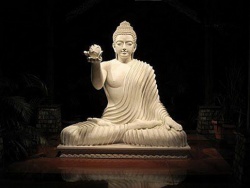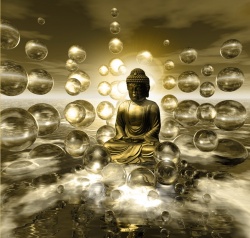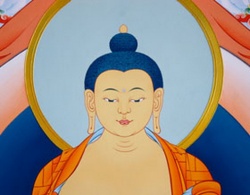Difference between revisions of "Lu-Tsung"
(Created page with "thumb|250px| <poem> The '''Lu-tsung school''' is the school of discipline. These disciplinary rules were given by the Buddha to deter members of the mo...") |
|||
| Line 1: | Line 1: | ||
[[File:Buddblotus.jpg|thumb|250px|]] | [[File:Buddblotus.jpg|thumb|250px|]] | ||
<poem> | <poem> | ||
| − | The '''Lu-tsung school''' is the school of discipline. These disciplinary rules were given by the Buddha to deter members of the monastic community (Sangha) from inappropriate behavior in the future. As the Buddhist Sangha developed, specific rules and rites were enacted that differ in Buddhist monasteries depending upon time and place. The rules by which the monks are judged and the punishments that should be assessed are found in the Vinaya tests (Vinaya literally means "That Which Leads"). | + | The '''[[Lu-tsung]] school''' is the school of [[discipline]]. These disciplinary rules were given by the [[Buddha]] to deter members of the [[monastic community]] ([[Sangha]]) from inappropriate {{Wiki|behavior}} in the future. As the [[Buddhist]] [[Sangha]] developed, specific rules and [[rites]] were enacted that differ in [[Buddhist]] [[monasteries]] depending upon [[time]] and place. The rules by which the [[monks]] are judged and the punishments that should be assessed are found in the [[Vinaya]] tests ([[Vinaya]] literally means "That Which Leads"). |
| − | In funding this school in China, Tao-Hsuan(596-667) wished to emphasis that in Buddhism the observance of the monastic rules is an essential part of practice. He also stressed the importance of the correct performance of ordination and in his monastery he firmly established the formalities for the consecration of a monk. Tao-Hsuan further addressed that although Vinaya is of Hinayana origin it was also regarded as authoritative by the Mahayana, therefore the Vinaya practice itself should be able to cover the entire teachings of the Buddha. Two Mahayana sutras were commented by him with the intention of integrating Vinaya's Hinayana standpoints into a broader scope, these two sutras are: | + | In funding this school in [[China]], Tao-Hsuan(596-667) wished to emphasis that in [[Buddhism]] the [[observance]] of the [[monastic]] rules is an [[essential]] part of practice. He also stressed the importance of the correct performance of [[ordination]] and in his [[monastery]] he firmly established the formalities for the [[consecration]] of a [[monk]]. Tao-Hsuan further addressed that although [[Vinaya]] is of [[Hinayana]] origin it was also regarded as authoritative by the [[Mahayana]], therefore the [[Vinaya]] practice itself should be able to cover the entire teachings of the [[Buddha]]. Two [[Mahayana sutras]] were commented by him with the [[intention]] of integrating Vinaya's [[Hinayana]] standpoints into a broader scope, these two [[sutras]] are: |
| − | The Brahman Net (Chinese, Fan-Wan) Sutra: addresses the disciplinary rules for Mahayana Bodhisattva-Sangha. | + | The [[Brahman]] Net ({{Wiki|Chinese}}, Fan-Wan) [[Sutra]]: addresses the disciplinary rules for [[Mahayana]] Bodhisattva-Sangha. |
| − | Treatise of the Accomplishment of the Yogi Masters (Chinese, Wie-Jia-She-De-Lun): defines 4 severe rules and 40 light rules for Bodhisattva. | + | Treatise of the [[Accomplishment]] of the [[Yogi]] [[Masters]] ({{Wiki|Chinese}}, Wie-Jia-She-De-Lun): defines 4 severe rules and 40 [[light]] rules for [[Bodhisattva]]. |
| − | According to Tao-Hsuan's comments, practicing the Five Precepts and the Eight Precepts (see below) is the only way to ensure the rebirth in the human realm and the heavenly realm and the bhikkhus' and bhikkhunis' rules are the only path to the ultimate enlightenment. | + | According to Tao-Hsuan's comments, practicing the [[Five Precepts]] and the [[Eight Precepts]] (see below) is the only way to ensure the [[rebirth]] in the [[human realm]] and the [[heavenly realm]] and the [[bhikkhus]]' and [[bhikkhunis]]' rules are the only [[path]] to the [[ultimate]] [[enlightenment]]. |
| − | The Five Precepts: | + | The [[Five Precepts]]: |
| − | I undertake the precept to refrain from | + | I undertake the [[precept]] to refrain from |
[[File:Buddha 2sw.jpg|thumb|250px|]] | [[File:Buddha 2sw.jpg|thumb|250px|]] | ||
Destroying living creatures. | Destroying living creatures. | ||
| Line 19: | Line 19: | ||
Taking that which is not given. | Taking that which is not given. | ||
| − | Sexual misconduct. | + | {{Wiki|Sexual}} misconduct. |
| − | Incorrect speech. | + | Incorrect [[speech]]. |
| − | Intoxicating drinks and drugs which lead to carelessness. | + | [[Intoxicating]] drinks and [[drugs]] which lead to [[carelessness]]. |
| − | The Eight Precepts: | + | The [[Eight Precepts]]: |
| − | I undertake the precept to refrain from | + | I undertake the [[precept]] to refrain from |
destroying living creatures. | destroying living creatures. | ||
| Line 33: | Line 33: | ||
taking that which is not given. | taking that which is not given. | ||
| − | sexual activity. | + | {{Wiki|sexual}} [[activity]]. |
| − | incorrect speech. | + | incorrect [[speech]]. |
| − | intoxicating drinks and drugs which lead to carelessness. | + | [[intoxicating]] drinks and [[drugs]] which lead to [[carelessness]]. |
| − | eating at the forbidden time (i.e., after noon). | + | eating at the forbidden [[time]] (i.e., after noon). |
| − | dancing, singing, music, going to see entertainments, wearing garlands, using perfumes, and beautifying the body with cosmetics. | + | [[dancing]], singing, {{Wiki|music}}, going to see entertainments, wearing garlands, using [[perfumes]], and beautifying the [[body]] with cosmetics. |
| − | lying on a high or luxurious sleeping place. | + | lying on a high or luxurious [[sleeping]] place. |
| − | During the time when Tao-Hsuan constructing the theoretical structure of this school, he visited Hsuan-tsang's (600-664) sutra translation institute at Chun-an very often and adopted the model of Buddha's teaching from Fa-hsiang school to address the Vinaya teaching. He defined three types of "Disciplinary Body" and assigned them to Fa-hsiang school's "three periods of teaching" as the core subjects taught by the Buddha during the different periods. Each period is a section of teaching that satisfied various audiences in different circumstance, and the Disciplinary Bodies associated with these periods are: | + | During the [[time]] when Tao-Hsuan constructing the {{Wiki|theoretical}} structure of this school, he visited Hsuan-tsang's (600-664) [[sutra]] translation institute at Chun-an very often and adopted the model of [[Buddha's teaching]] from [[Fa-hsiang]] school to address the [[Vinaya]] [[teaching]]. He defined three types of "Disciplinary [[Body]]" and assigned them to [[Fa-hsiang]] school's "three periods of [[teaching]]" as the core [[subjects]] taught by the [[Buddha]] during the different periods. Each period is a section of [[teaching]] that satisfied various audiences in different circumstance, and the Disciplinary [[Bodies]] associated with these periods are: |
| − | The Existence (Agamas) Teaching: The subject of material forms or appearances (rupa-dharma) is the Disciplinary Body. | + | The [[Existence]] ([[Agamas]]) [[Teaching]]: The [[subject]] of {{Wiki|material}} [[forms]] or [[appearances]] (rupa-dharma) is the Disciplinary [[Body]]. |
| − | The Emptiness (Prajnaparamita) Teaching: The subject of non-material forms and non-mental dharmas are the Disciplinary Body. | + | The [[Emptiness]] ([[Prajnaparamita]]) [[Teaching]]: The [[subject]] of non-material [[forms]] and non-mental [[dharmas]] are the Disciplinary [[Body]]. |
| − | The Middle Way (Avatamsaka) Teaching: The subject of mental dharmas (cittadharma) is the Disciplinary Body. | + | The [[Middle Way]] ([[Avatamsaka]]) [[Teaching]]: The [[subject]] of [[mental]] [[dharmas]] (cittadharma) is the Disciplinary [[Body]]. |
| − | Although there were a lot of outstanding masters studied and practiced this school, it has been blended with other Buddhist lineage as part of the general monastery rules after Tang dynasty. Rituals were once exclusive to the school became part of the activities in other Buddhist communities. This trend eventually prevents the school to survive as an independent system. | + | Although there were a lot of [[outstanding]] [[masters]] studied and practiced this school, it has been blended with other [[Buddhist]] [[lineage]] as part of the {{Wiki|general}} [[monastery]] rules after {{Wiki|Tang dynasty}}. [[Rituals]] were once exclusive to the school became part of the [[activities]] in other [[Buddhist]] communities. This trend eventually prevents the school to survive as an independent system. |
</poem> | </poem> | ||
{{R}} | {{R}} | ||
Latest revision as of 15:30, 17 September 2013
The Lu-tsung school is the school of discipline. These disciplinary rules were given by the Buddha to deter members of the monastic community (Sangha) from inappropriate behavior in the future. As the Buddhist Sangha developed, specific rules and rites were enacted that differ in Buddhist monasteries depending upon time and place. The rules by which the monks are judged and the punishments that should be assessed are found in the Vinaya tests (Vinaya literally means "That Which Leads").
In funding this school in China, Tao-Hsuan(596-667) wished to emphasis that in Buddhism the observance of the monastic rules is an essential part of practice. He also stressed the importance of the correct performance of ordination and in his monastery he firmly established the formalities for the consecration of a monk. Tao-Hsuan further addressed that although Vinaya is of Hinayana origin it was also regarded as authoritative by the Mahayana, therefore the Vinaya practice itself should be able to cover the entire teachings of the Buddha. Two Mahayana sutras were commented by him with the intention of integrating Vinaya's Hinayana standpoints into a broader scope, these two sutras are:
The Brahman Net (Chinese, Fan-Wan) Sutra: addresses the disciplinary rules for Mahayana Bodhisattva-Sangha.
Treatise of the Accomplishment of the Yogi Masters (Chinese, Wie-Jia-She-De-Lun): defines 4 severe rules and 40 light rules for Bodhisattva.
According to Tao-Hsuan's comments, practicing the Five Precepts and the Eight Precepts (see below) is the only way to ensure the rebirth in the human realm and the heavenly realm and the bhikkhus' and bhikkhunis' rules are the only path to the ultimate enlightenment.
The Five Precepts:
I undertake the precept to refrain from
Destroying living creatures.
Taking that which is not given.
Sexual misconduct.
Incorrect speech.
Intoxicating drinks and drugs which lead to carelessness.
The Eight Precepts:
I undertake the precept to refrain from
destroying living creatures.
taking that which is not given.
sexual activity.
incorrect speech.
intoxicating drinks and drugs which lead to carelessness.
eating at the forbidden time (i.e., after noon).
dancing, singing, music, going to see entertainments, wearing garlands, using perfumes, and beautifying the body with cosmetics.
lying on a high or luxurious sleeping place.
During the time when Tao-Hsuan constructing the theoretical structure of this school, he visited Hsuan-tsang's (600-664) sutra translation institute at Chun-an very often and adopted the model of Buddha's teaching from Fa-hsiang school to address the Vinaya teaching. He defined three types of "Disciplinary Body" and assigned them to Fa-hsiang school's "three periods of teaching" as the core subjects taught by the Buddha during the different periods. Each period is a section of teaching that satisfied various audiences in different circumstance, and the Disciplinary Bodies associated with these periods are:
The Existence (Agamas) Teaching: The subject of material forms or appearances (rupa-dharma) is the Disciplinary Body.
The Emptiness (Prajnaparamita) Teaching: The subject of non-material forms and non-mental dharmas are the Disciplinary Body.
The Middle Way (Avatamsaka) Teaching: The subject of mental dharmas (cittadharma) is the Disciplinary Body.
Although there were a lot of outstanding masters studied and practiced this school, it has been blended with other Buddhist lineage as part of the general monastery rules after Tang dynasty. Rituals were once exclusive to the school became part of the activities in other Buddhist communities. This trend eventually prevents the school to survive as an independent system.


